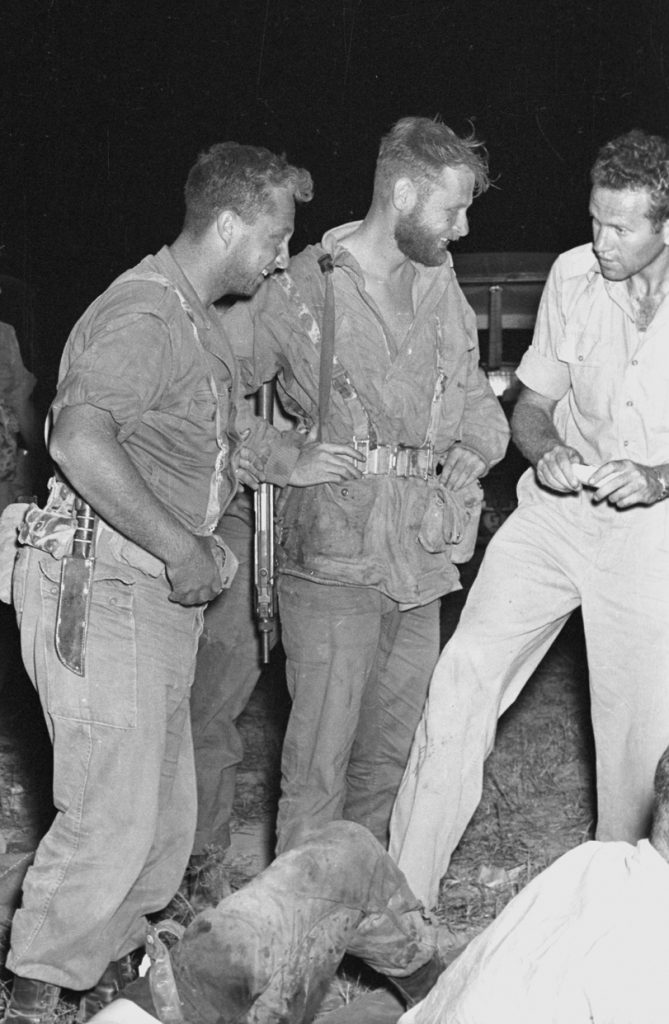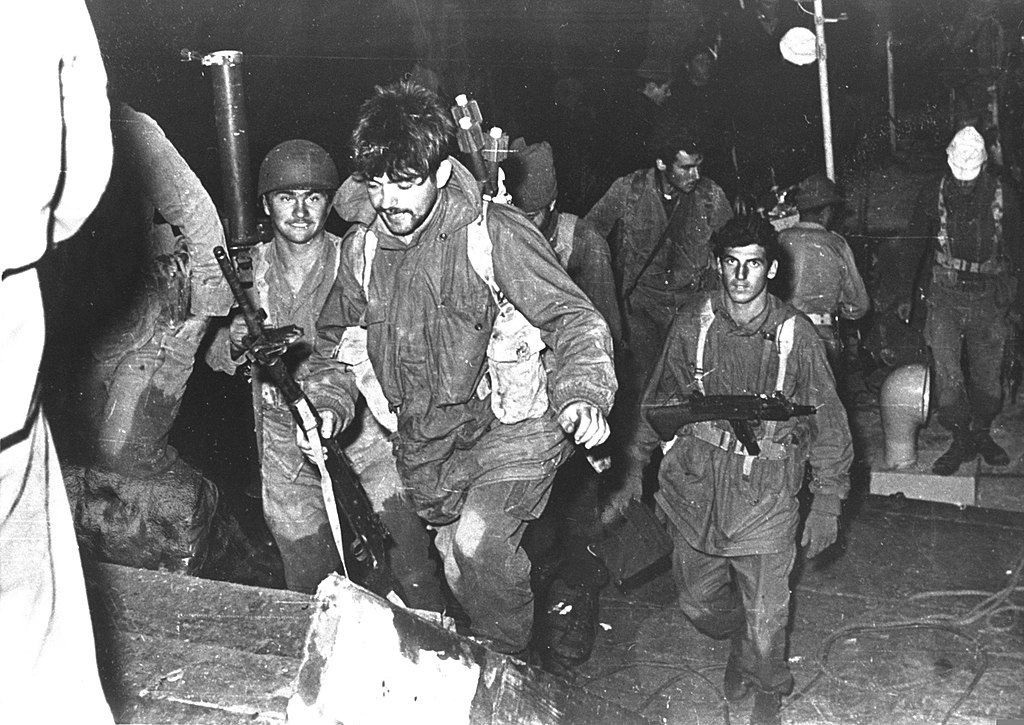The Zionist movement has created a unique warrior myth that is implemented in everyday practice to this very day

Copyright: Israeli GPO photographer [Public domain]

Copyright: Israeli GPO photographer [Public domain]
The saga of Zionism, of the successful (beyond anyone’s wildest imagination) endeavor to rebuild Jewish independence in the Land of Israel is a deeply spiritual, religious, and nationalist journey. Above all else, though, it is the story of unparalleled military success. I say “above all” because without the military success none of the other successes would have been possible and because the military component in the 150-year Zionist story is as old as the story itself.
The story of Zionist militarism has long been hijacked by the public relation arms of both Zionists and their opponents and as such has had little objective scrutiny. Yet it informs every aspect of modern Israeli culture and shapes it like nothing else. Zionists, a group that includes me, have waged and still are waging a PR campaign that claims all Jewish military activities in the Land of Israel to have been purely defensive. Anti-Zionist and, lately, progressive Zionist circles claim that they have been almost or almost always aggressive.
The truth is not found in either of these poles, nor anywhere in between. The truth, as is almost always the case, is much more pragmatic. Zionist military prowess has always played a supporting role to the Zionist goal of reestablishing an independent Jewish polity in Zion or as our national anthem states: “To be a free nation in our Land, the land of Zion and Jerusalem”. From its very inception, the Zionist movement has been steadfast in interpreting “freedom” to exist only if the large majority of the population within the geography under its control is Jewish. This lesson is one that the Boers of South Africa would have been well-advised to learn.
The achievement of the goals of Jewish independence and Jewish majority from the military perspective required from the earliest days of the Zionist movement in the1880s to this very day a mixture of defensive and aggressive measures, depending on the situation and, importantly, on the military capabilities available at any given time. This pragmatic approach dictated and still dictates that the geographic, political, social, and economic goals of Zionism be subordinate to the primary directives of independence and majority and to the military effort that is needed to make achieve these goals.
In the earliest days of Jewish settlement under the auspices of the Ottoman Empire, most measures were defensive, sometimes with a retaliatory component. As the number of Jews grew and so did the Arab animus, retaliatory component became more dominant. In the 1948 War of Independence, the British expeditious departure and the lack of organization and coordination among the regular and irregular Arab forces provided many targets of opportunity for Jewish military aggression both in terms of capturing territories not allocated to the Jewish State in the UN partition resolution and in terms of clearing these and other territories from their Arab inhabitants.
As an ardent Zionist, I do not use the term “aggressive” in any pejorative way; rather I use it in a purely technical military sense. From the perspective of the Zionist movement, military aggression was not only justified, it was absolutely essential. The partition borders were utterly indefensible and leaving a larger hostile population within them would have resulted in the loss of the Zionist project and a second Holocaust. The 1950’s cross-border raids by Arabs residing alongside the new state of Israel and the shelling of Israeli villages by Syria made this point abundantly clear.
These hostile actions have made it abundantly clear to Israeli civilian and military leadership that static defense was not an option for the young country. In the event of a war, the Israel Defense Forces (IDF) had to strive to immediately take the action to the enemy. Attack, immediate attack, was the only option.
From this geopolitical reality, from Israel’s pre-1967 “narrow waist” and “Auschwitz borders” to use foreign minister’s Abba Eban’s coinage, was born the ethos of the Israeli warrior. What are the hallmarks of this particular soldier? First and foremost, it is the automatic, reflexive transition to attack mode. All Israeli combat soldiers are taught in basic training that should they get fired on by the enemy, they must IMMEDIATELY upon identifying the source of the fire close with the enemy and eliminate him. This is drilled repeatedly and failure to do so even today is grounds for immediate dismissal from combat duties. Israeli warriors are trained to SEEK contact with the enemy, not avoid it.
Second is the principle of adherence to the task. An Israeli soldier is expected to put his immediate objective above everything and stick to it no matter what. He is expected to be at once resourceful and pigheaded in how he carries out his duties. Even junior commanders, such as sergeants and lieutenants are expected to think out of the box if that is required to achieve their objectives.
Finally, an Israeli warrior is expected to always carry in his heart the thought of killing his enemy. Miyamoto Musashi, the legendary early 17th century Japanese samurai and swordsman wrote in his “Book Of Five Rings” that a warrior, upon placing his hand on the hilt of his katana should always think of thrusting it through the heart of his enemy. IDF teaches that once you chamber a round you are committed to putting that round into your enemy’s body and killing him.
The 1950’s produced a number of legendary warriors who went on to shape the military and the civilian life in Israel. The most famous among them was the late prime minister Ariel Sharon. These guys were supposed to be larger than life; physically as beautiful as they were indefatigable, able to walk 30 miles cross country at night with full gear, engage the enemy and then walk back carrying their dead and wounded. Surprisingly, they were all that and more.
A military the size of the IDF cannot rely on myth alone. It needs practical ways of taking spoiled Jewish mama’s boys (and in the last four decades or so, girls) and making out of them warriors with “murder in their eyes”. To this end, the IDF had to define who was a warrior and who was not. The definition is intentionally rather broad: if you operate a weapon system, be it a rifle or the Iron Dome interceptor, you are a warrior. If you fix weapon systems, cook meals, drive things or people around, etc., you are not.
The warrior/non-warrior divide is the most critical in the IDF and it has deep meaning along several axes. First, warriors, even those who operate highly defensive systems such as anti-aircraft and anti-missile batteries, undergo enhanced infantry training throughout their advancement through the ranks: basic training, company commander training, and officer training. This is true for both men and women. Warriors are never without a personal firearm. I am often, still to this day, surprised by people who wonder at the many soldiers who walk around Israeli cities with their rifles and by my own reaction when I see American soldiers wonder around airports and other places unarmed. The idea of a combat soldier who is unarmed while in uniform at any point in time is utterly alien to me.
Warriors have distinguishing insignia, most visibly a red background behind other insignia such as ranks, branches of service, etc. Those warriors who stay on to serve beyond the obligatory period of time and receive market competitive pay, enjoy higher pay than a comparable non-warrior rank. In total, there is a definite glamor, a definite pride that goes with the label “combat soldier” in Israel. Your rifle, from which you are never separated, serves as constant reminder that you have the responsibility, the training, and the duty, to close with the enemy and kill him no matter where you may find him, which in Israel can be anywhere.
There are instances when Israeli warriors shamefully fail to act like ones. This was the case when Gilead Shalit’s tank was ambushed just outside of Gaza in 2006. The tank drove over a powerful IED and immediately thereafter was attacked by a group of terrorists who crossed into Israel using an underground tunnel. Two of Shalit’s crew were killed as were two Arabs and two were badly wounded. Shalit sustained no injuries and allowed himself to be taken captive dragging the whole of Israel through a five-year nightmare at the end of which more than a thousand Arab terrorists, most of them with Jewish blood on their hands, were released to secure his return.
As was expected most of those released returned to the fight against Israel and one can only imagine what the families of their victims in Israel felt upon seeing the joyous reception they had received in Gaza. Shalit’s actions and the Israeli public’s reaction to them and to the price that was paid to secure his release and return him to his family tell us much about the warrior ethos in Israel. The fact that Shalit alone was uninjured and that he had allowed himself to be captured in this state tells you all you need to know about him as a warrior. All of Israel averted its gaze, as one does when someone comes across something particularly unseemly. Shalit’s father was, naturally, a tireless fighter for his freedom. No price was too high to pay for it as far as he was concerned. Not a single bad word was said about him. When the horrendous price was finally paid, most took a deep breath and agreed. The idea of leaving a Jewish boy to die in Hamas prison never seeing the light of day was just not possible, no matter the price.
This dedication to Jewish life, to its preservation, on both the individual and collective levels, is, after all, the reason we have an independent state and one of the world’s finest armed forces. Shalit was not a warrior, but he was (and of course still is) a Jew and as such he deserved the unconditional support of all of us. Nobody can be asked to put his life at risk when those who do the asking are not totally committed to his wellbeing no matter what. Israeli warriors do not have to worry about that.
- Saudi Aramco Still Scrambling For A Fist Full Of Dollars
- The Hi-Tech Traditionalist: Emasculated Mutilated Castrated American Christianity And Judaism Are Holding Hands As They Are Jumping Off The Cliff Of Oblivion


